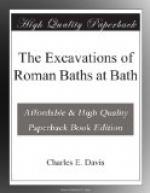ON THE EXCAVATIONS OF THE ROMAN BATHS AT BATH.
Re-printed from the Transactions of the Bristol and Gloucestershire Archaeological Society, Vol. Viii., Part I.
[Plate V: City of Bath. Plan of Roman Baths.]
Leland, on his visit to Bath in the year 1530, with tolerable fulness describes the baths, and after completing his description of the King’s Bath goes on to say “Ther goith a sluse out of this Bath and servid in Tymes past with Water derivid out of it 2 places in Bath Priorie usid for Bathes: els voide; for in them be no springes;” and further on he says “The water that goith from the Kinges Bath turnith a Mylle and after goith into Avon above Bath-bridge.”
These two sentences have hitherto been difficult of explanation, but the excavations, which it has been my good fortune to superintend, and the discoveries I have made, have fully explained Leland’s meaning, at the same time that I have brought to light the great Roman Bath, which I purpose describing in detail in this paper, writing only of previous excavations and those I have conducted in connection with this work, so far as their description may the more fully render my account perfect of the Great Bath itself. I desire to confine my paper within such limits as the space afforded me in this Journal necessarily imposes.
Some time during the last century the ruins of a mill wheel were found to the south of the King’s Bath. I have in my excavation discovered the mediaeval sluice that led to this wheel. Leland speaks of “two places in Bath Priorie used for Bathes els voide.”
In a map of Bath preserved in the Sloane Collection of the British Museum, drawn by William Smith (Rouge Dragon Pursuivant at Arms) a few years previous to 1568,[1] is an open bath immediately to the south of the Transept of the Abbey called “the mild Bathe."[2] This, or at any rate what I may consider was the “mild bath,” I found in my explorations beneath the soil at a situation in York Street, connected with the Hot-water drains, the bath being still provided with a wooden hatch, and of the dimensions of a good sized room.[3] The other place mentioned by Leland was discovered in 1755, and this discovery led the way to the excavations of a great bath (afterwards called Lucas’s Bath), when the eastern wall of the great Hall of the recently found bath was first laid open, although from its position not having been properly noted previous to its being covered up, its situation remained unknown for nearly 130 years.
[Footnote 1: Mr. Peach, in the preface to “the Historic Houses in Bath,” page 5, quotes 1572; but this is the date of the completion of Mr. Smith’s book, the drawings of which occupied many years.]
[Footnote 2: Mr. Smith gives a list of “Wonders in England”: 1st. “The Baths at ye Citty of Bath are accompted one although yet they are not so wonderfull seeing that ye Sulphur and Brimston in the earth is the cause thereof but this may pass well enough for one.”]




